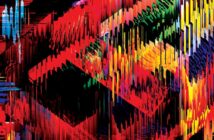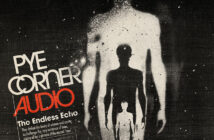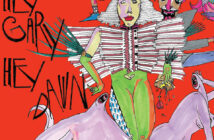The Icelandic based, avant-classical composer, Johann Johannson has released a new album so rich in ideas it’s hard to know where to begin, but it makes sense to me to back track a little to his first solo work Englaborn. Fans of this album will already be familiar with the title track, ‘Odi Et Amo’. It features the computerised voice of a counter-tenor reciting a famous latin poem by Catallus. The poem itself addresses the polar extemes of all-consuming love and hate. Of interest here is the cyborgian recontextualisation, a non-sentient machine recounting the ancient tale of both agonising elation and grief in human experience. The relationship between man and machine, history and future, longing and death, human foible and artificial intelligence is established as a primary concern throughout the masterpiece that is Englaborn. These concepts flow to find even greater space in Johannson’s latest offering IBM 1401, A User’s Manual.
As the album title suggests, the now obsolete IBM 1401 provided the starting point of inspiration for the work. It’s an interesting history that begins with the tale of Johannson’s father who, as one of the key engineers, worked on this mammoth mainframe computer when it first arrived in Iceland. During this time he discovered that the electromagnetic waves emitted by the computer could be coaxed into simple melodies which he then began recording as an experimental side project.

Look how compact the IBM 1401 really is!
Now over 30-years later, the IBM 1401 is remembered kindly in its obsoletion as these early reel-to-reel tape recordings are resurrected in what is a very personal homage to the dawn of the computer age, bringing with it the first digital music in Iceland. The music also evolved out of an intensive, on-going dialogue with choreographer Erna Ómarsdóttir. First composed for a string quartet, Johannson’s early work punctuated Erna’s dance performance. With all the ideas set in place, Johannson then set out to ambitiously re-score and record the work with a 60-piece orchestra for the final album version. In addition, he wrote a closing track based on Dorothy Parker’s Two Part Novel. A very simple poem, laid out from beginning to end in a single stanza:
The sun’s gone dim, and
The moon’s turned black;
For I loved him, and
He didn’t love back.
Here lies a simple device that reaffirms the earlier work of ‘Odi Et Amo’. To quote Johannson’s question, “When computers will be so advanced they can simulate consciousness well enough to convince us of their humanity, they will, as our mechanical descendants, look to us, their creators, for recognition. And when that moment comes, who are we to deny them the status of sentient beings?” While the future is yet to be determined, I’d like to return to the fact of this work being a homage to early computing. My first impression upon first listening was that Johannson has done for computers what Dziga Vertov’s Man With A Movie Camera did for ‘the Kino Eye’, (the first motion cameras) in documenting the birth of cinematography. While Vertov illustrated the energy and utopia of this new moment in time, the dawn of a new tool that he intended to use as a means to raise human conciousness, he also couldn’t benefit from hindsight. It’s this hindsight that creates an emotionally stirring, tonal counterbalance in IBM 1401 – A User’s Manual. Striking is the voice of the computer, its melancholy timbre encapsulating not only a mood of birth, like the joy of watching a child take its first steps, but also the knowing consciousness of mortality. Johannson has achieved this contrast seamlessly by juxtaposing elements of the computer’s samples with lofty orchestration. He also includes excerpts from an audio user’s manual that introduces an entirely new language and, with it, a new world view. Consider the wondrous quality of these instructions:
The drive housing checks should consist of the following points:
1. The idler – there should be no sign of wear or play
2. Make sure that the adjusting hubnut of the running drive gear is not loose
3. The wormshaft should have no endplay. If necessary take off some of the shims to compensate for the play of the tinkin ball-bearing.
Here Johannson conveys how foreign and exotic this new creature, this hulking, heavy, and thunderously noisy creation that the mainframe computer really was. He also stunningly combines a sense of uniqueness and permanence in one breath whilst exhaling the transitoriness of mass reproduction in another. Something that the famous French flaneur, Walter Benjamin, couldn’t foresee at the time he was writing his essay on The Work of Art in The Age of Mechanical Reproduction. In 1938 he believed that the ability to reproduce works infinitely dispels the essential ‘aura’ of an artwork, thus lessening the power of the experience for audiences. Here we are over 60-years later experiencing the effects of his premonitions yet we have moved so far from what his world was like. We not only accept replication, we also embrace it and the machines that make it possible with a love and tenderness that seems to, in my mind, restore some of the magic of ‘aura’ that Benjamin grieves for. And in this era, we have works like IBM 1401 – A User’s Manual to prove it. An album with this much space for thought is nothing but essential listening.
In the meantime, check out the computer smut for nerds! I mean, aherm…sound and image of the mainframe at work.
Renae Mason.




